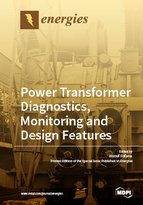Power Transformer Diagnostics, Monitoring and Design Features
A special issue of Energies (ISSN 1996-1073).
Deadline for manuscript submissions: closed (15 February 2016) | Viewed by 97879
Special Issue Editor
Interests: Electromagnetic compatibility; Electrical engineering; Electrical insulation; Dielectric materials; Problems associated with the transport and distribution of electrical energy
Special Issues, Collections and Topics in MDPI journals
Special Issue Information
Dear Colleagues,
Transformers are key components in electric power distribution and transmission systems and it is essential that they function properly for many years. With increasing age, there are potential risks of extremely high monetary losses due to unexpected failures and outages. The fundamental objective is to promote the longest possible service life, to minimize lifetime operating costs, and to predict the time ripped to remove the transformer, on a planned basis, for revision or replacement. For these reasons, transformer life management gained the past decades an ever-increasing interest due to economic and technical reasons. The greatest challenges are related to the need for methods to assess the condition and life expectancy along with the improvement of transformers efficiency by noble designs and or application of new materials. The Special Issue will cover theoretical and practical developments with special emphasis on new R&D trends in transformer designs and transformer diagnostic and maintenance recent challenges. Topics of interest for publication include, but are not limited to:
- new or emerging diagnostic/monitoring technologies
- mineral oils of improved characteristics, additives
- nanofluids and synthetic/vegetable dielectric liquids
- new materials for transformers
- transformer life management
Prof. Dr. Ing. Issouf Fofana
Guest Editor
Manuscript Submission Information
Manuscripts should be submitted online at www.mdpi.com by registering and logging in to this website. Once you are registered, click here to go to the submission form. Manuscripts can be submitted until the deadline. All submissions that pass pre-check are peer-reviewed. Accepted papers will be published continuously in the journal (as soon as accepted) and will be listed together on the special issue website. Research articles, review articles as well as short communications are invited. For planned papers, a title and short abstract (about 100 words) can be sent to the Editorial Office for announcement on this website.
Submitted manuscripts should not have been published previously, nor be under consideration for publication elsewhere (except conference proceedings papers). All manuscripts are thoroughly refereed through a single-blind peer-review process. A guide for authors and other relevant information for submission of manuscripts is available on the Instructions for Authors page. Energies is an international peer-reviewed open access semimonthly journal published by MDPI.
Please visit the Instructions for Authors page before submitting a manuscript. The Article Processing Charge (APC) for publication in this open access journal is 2600 CHF (Swiss Francs). Submitted papers should be well formatted and use good English. Authors may use MDPI's English editing service prior to publication or during author revisions.
Keywords
- power transformers
- insulating liquids
- insulating solids
- transformer design
- aging
- diagnostic and monitoring
- life management
- transformer components






